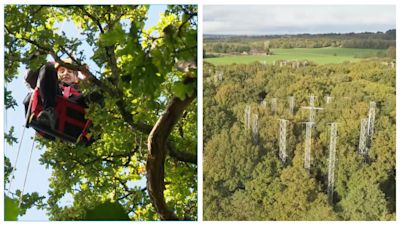Insight
'We need to do our bit': Inside the Stafford forest helping scientists tackle the climate crisis

I’m hanging around 25 metres in the air, attached to a metal tower overlooking the forest rooftop when the scale of this world-leading project really hits me.
At BIFOR (Birmingham Institute of Forest Research) near Stafford, hundreds of trees have time travelled virtually into the future.
Scientists are subjecting them to the atmosphere our planet will be experiencing in 50 years' time by pumping carbon dioxide into the forest through black plastic piping.
Lewis explains how the gas is released into the forest
You’d be forgiven for thinking that letting CO2 out into the atmosphere isn’t the best way of tackling the climate emergency but from up here the importance of this project is evident.
Besides, this CO2 was destined for the atmosphere anyway, releasing it here only makes it that bit more useful, before it does its damage.
BIFOR Director, Professor Rob MacKenzie, told me: "Obviously, we think very carefully before we release carbon dioxide into the atmosphere.
"But we have to do this experiment in order to get some evidence ahead of time on how the forests will respond in the future."
He adds: "We wouldn't like to go into that future blind - that would be a terrible, terrible mistake."
To trees, CO2 is like food. Which is good, because we’re pumping it out like there’s no tomorrow - and if we’re not careful, there might not be.
Knowing how nature's jungle will react in the future is a key part of the scientific calculations that determine how much more damage we can afford to do.
The prime minister this week has been talking of ‘Keeping 1.5 alive’ - essentially saying let’s not lose hope of limiting global warming to 1.5°C degrees - despite even our current target of hitting 2.7°C looking like it’s melting away.
The ideal target of 1.5°C has been reached because we know how much these trees will help us. They love the extra carbon.
Lewis shows how scientists are lifted into the canopy to assess the impact of CO2 on leaves
The research here has shown that when more carbon is in the air around them, they take in up to 30% more. Thank you, Mother Nature.
But for decades we’ve been tearing down the very things that can help us out. According to National Geographic, between 1990 and 2016, the world lost 502,000 square miles (1.3 million square kilometres) of forest.
On Monday, at the COP26 summit in Glasgow, 100 nations agree to end deforestation by 2030.
Back down on the ground, I asked Rob how he felt about COP26. Many aren’t hopeful our world leaders will be able to agree on making enough change.
A researcher explains how they measure carbon dioxide levels
He said: “I really, really hope for some hard commitments to the reduction in fossil fuel use in COP26, because although the forest we're surrounded in now and forests all over the world are contributing a massive benefit to us by taking in carbon dioxide, they can never, ever absorb all the carbon dioxide that we are putting into the atmosphere.
"So we absolutely need to do our bit as humans by reducing the amount of coal, oil and gas that we use.”
So, we can’t rely on trees alone. They will help us on our journey to reach Net Zero carbon emissions (whenever that might be) but they can’t do all of the leg work.
Their roots may have been formed over decades but we’re still going to have to do some digging ourselves to find the answers to a problem we’ve created.